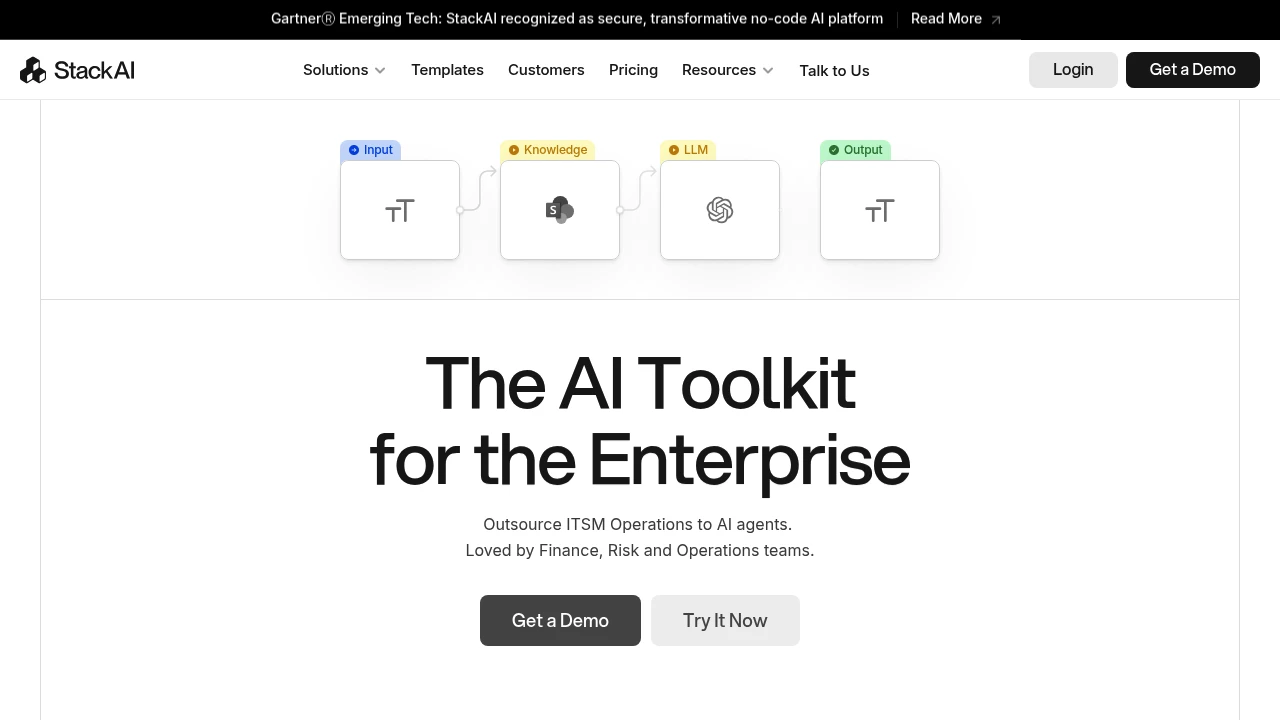Stack AI
Stack AI enables enterprises to build multi-modal AI agents using text, vision, and data.

Stack AI Features & Overview
Stack AI is a visual platform for building and deploying AI agents, chatbots, and workflow automations with enterprise controls. You draw the flow on a canvas, wire knowledge sources, pick models, and publish an interface or API in a few clicks. The system blends LLM orchestration, retrieval-augmented generation, and function calling with a large connector catalog. Teams add Python or JavaScript steps when needed, test on batches, log every run, and gate production with SSO and RBAC. Compliance options include SOC 2 and HIPAA, plus on-prem and VPC deployment.
Core Features
- Workflow Builder: Compose agents as node-based flows with inputs, LLM calls, tools, logic, and outputs. The canvas supports branching, retries, and variable mapping so you control data flow and error paths precisely.
- Knowledge Bases (RAG): Ingest documents from uploads, web, or drives, then query them with retrieval-augmented generation. Configure chunking, embeddings, and citation style, and route sensitive data to private vector stores.
- Function Calling and Tools: Expose internal actions as tools the model can call with structured arguments. Bind REST endpoints, database queries, or SaaS actions, and validate inputs before execution for safer runs.
- Multi-model Orchestration: Choose models from providers like OpenAI and Anthropic, including vision and speech variants. Route by task, switch providers per node, and set temperature, max tokens, and stop conditions for consistent outputs.
- Code Nodes (Python and JavaScript): Add deterministic logic without leaving the canvas. Use code to transform payloads, sign requests, sanitize inputs, or compute scores, then pass results to the next node.
- Integrations Catalog: Connect systems such as SharePoint, Salesforce, Workday, Snowflake, BigQuery, Pinecone, Weaviate, Gmail, Notion, and Slack. Authorize once, reuse across projects, and manage secrets centrally.
- Export and Deployment Options: Ship a chat UI, website widget, Slack or Teams app, WhatsApp or SMS via Twilio, batch jobs, or a clean REST API. Configure branding, custom domains, access rules, and rate limits.
- Evaluator for Quality: Test agents on CSV batches and score outputs with a grader model. Compare against gold answers or heuristics, track pass rates, and promote versions that meet accuracy targets.
- Analytics and Observability: Review execution logs with inputs, outputs, tokens, runtime, and node traces. Filter by date or status, spot failures, and replay problem runs to verify fixes.
- Manager and Memory: Inspect user conversations, clear history, and enable shared or per-session memory. Store summaries or facts for better answers while respecting role and dataset permissions.
- Security and Governance: Enforce SSO, granular RBAC, audit trails, and environment locks. Deploy in VPC or on-prem, and apply provider DPAs with configurable model allowlists for policy alignment.
- Performance Controls: Add caching, retries, and fallbacks, and tune chunk sizes and rerankers. Balance cost and latency by mixing small and large models across steps.
Supported Platforms / Integrations
- Slack, Microsoft Teams, WhatsApp and SMS via Twilio
- Google Drive, Notion, SharePoint for document sources
- Salesforce, Workday, HubSpot for business data
- Snowflake, BigQuery, PostgreSQL, MySQL for analytics and ops
- Pinecone, Weaviate, pgvector for vector search
- REST APIs, webhooks, and custom domains
Use Cases & Applications
- IT and Operations teams automating requests, ticket triage, and knowledge search
- Support organizations deploying secure chatbots across web and chat
- Finance and Ops teams running document intake, review, and enrichment
- Agencies packaging repeatable AI workflows for clients
Pricing
- Free: $0 per month; 500 runs per month, 2 projects, 1 seat, community support
- Enterprise: Contact sales; custom runs and seats, all features and data loaders, dedicated infrastructure and engineers, on-prem or VPC deployment, access control, SSO, SOC 2 and HIPAA options
Why You’d Love It
- Ships from canvas to live chatbot or API without extra glue work
- Connects to the systems you already use and governs access tightly
- Measures quality with batch evaluation before you roll out
Pros & Cons
Pros
- Visual builder with code and tool hooks for real control
- Strong connector set across data, SaaS, and vector stores
- Enterprise deployment options with SSO, RBAC, and audits
Cons
- Advanced governance features sit on Enterprise plans
- Best performance requires careful prompt and retrieval tuning
Conclusion Stack AI gives teams a practical way to launch agents that use real company data and actions. You design the flow, connect sources, test quality, and deploy to web or chat with guardrails that satisfy IT. The result is faster delivery and safer automation across departments.